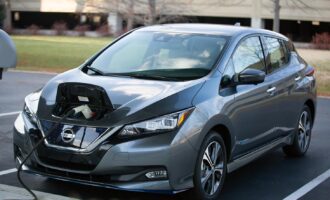China vs. India: The Battle for Electrification World Domination
By Aaron Stone
Let the battle commence. China and India have both announced plans to ban petrol and diesel vehicles as the new energy vehicle (NEV) insurgency gathers momentum. The declaration from two of Asia’s spearheads follows earlier commitments in several European countries. In July, Ecology Minister Nicolas Hulot announced France would cease sales of petrol and diesel vehicles by 2040. Soon after, Britain disclosed an identical timeframe as part of the government’s new clean air plan. Norway has publicised even more impressive plans, confirming all new passenger cars and vans sold in 2025 should be zero emission.
While China and India are clearly not the first to announce such sweeping changes, the world’s two most populous nations clearly have designs on becoming global forerunners in the electrification of vehicles. Fulfilling obligations as signatories of the Paris Climate Accord is a key driver, though reducing the devastating impact of pollution in certain areas of each nation remains of utmost importance.
India, home to 1.3 billion people, is the world’s fifth-largest auto market with 21 million vehicles sold annually. The South Asia nation plans to shift entirely to electric vehicle sales by 2030, arguably the most ambitious new energy transformation of any country. Prime Minister Narendra Modi is driving a renewable-energy revolution, with plans to roll out a national policy for electric vehicles (EV) in December to establish standards, guidelines and incentives for electric vehicles.
Aside from the obvious environmental benefits, many of India’s cities are among the world’s most polluted, the Indian government has highlighted substantial economic benefit from this change. 82% of India’s oil requirements are currently imported. A joint report produced by NITI Aayog and Rock Mountain Institute suggests accelerating the adoption of alternatives to fossil fuels could reduce their oil bill by as much as USD60 billion by 2030.
To date, India’s attempts to accelerate the adoption of new energy vehicles have been largely unsuccessful. A 2015 scheme entitled ‘Faster Adoption and Manufacturing of Hybrid and Electric Vehicles’ (FAME) has failed to deliver a material impact with demand in India remaining subdued. In the year ending 31 March 2016 only 22,000 EV units were sold, of which only 2,000 are four wheelers, according to industry lobby group the Society of Manufacturers of Electric Vehicles (SMEV). The target of six to seven million electric and hybrid car sales, set by the National Electric Mobility Mission Plan, seems a long road. However, the Indian government is not about to sit idly and miss this gargantuan opportunity.
If Modi is the visionary behind a clean energy revolution, India’s Road Transport Minister Nitin Gadkari is his enforcer. Speaking to India’s automobile lobby group, SIAM, on September 7 Gadkari told representatives that India is going to move to alternative fuel “whether you like it or not.” Perhaps detecting the presence of conscientious objectors, the minister added “I am not going to ask you. I will bulldoze it.”
In further evidence of the boldness of Modi’s electrification plans, India announced that it will roll out nearly 100,000 battery-powered buses and autorickshaws within a few weeks, providing considerable impetus towards a 2030 deadline. While India clearly has ambition, most expect China to assume global leadership in the path to new energy vehicles (NEV). China is the world’s largest auto market with 200 million registered vehicles and achieved cumulative sales of more than 951,000 units of NEVs to December 2016. China is also home to nine out of the top 20 selling EV brands worldwide.
 While China has not yet committed to a timeline for the phase-out of vehicles operating on traditional fuels, China’s Vice Minister of Industry and Information Technology, Xin Guobin, told an auto forum in Tianjin on September 9 that research on a timetable to phase out production and sales of fossil fuel cars has commenced. The Chinese government is a staunch supporter of NEVs, recognizing their beneficial role in easing environmental pressures, and already has in place a myriad of measures to encourage uptake including tax exemptions and discounts for new purchases.
While China has not yet committed to a timeline for the phase-out of vehicles operating on traditional fuels, China’s Vice Minister of Industry and Information Technology, Xin Guobin, told an auto forum in Tianjin on September 9 that research on a timetable to phase out production and sales of fossil fuel cars has commenced. The Chinese government is a staunch supporter of NEVs, recognizing their beneficial role in easing environmental pressures, and already has in place a myriad of measures to encourage uptake including tax exemptions and discounts for new purchases.
Conflicting opinions exist within the industry on what China’s deadlines might be. Zhong Shi, an independent auto industry analyst in Beijing, has suggested China might adopt a deadline earlier than France and Britain, citing the countries’ relatively short history of car use as contributory in achieving an earlier date. Conversely, Qiu Kaijun, an industry observer, disagrees with Shi claiming the sheer size of the China market means it would take much longer to transform the automobile sector. Qiu also speculated that a differentiated timetable could be adopted, with big cities like Beijing and Shanghai preceding adoption in less developed regions.
Despite an acknowledgment of the critical role electrification plays in future automotive technology, it seems China is not placing all its eggs in one basket. Conscious of the barriers to electric car adoption and a necessity to fulfill its commitments to the Paris Climate Accord, China is also pioneering a shift to ethanol. Ethanol-blended gasoline in vehicles can reduce harmful tailpipe emissions of carbon monoxide, media, suggests ethanol blends will be used to fuel vehicles nationwide by 2020. The rollout extends a trial of the fuel that has been ongoing in 11 regions.
The conversion to electric vehicles certainly won’t be a silky-smooth road. At present electric vehicles are expensive, and in many countries, such as India, there is a severe lack of infrastructure to maintain pace with demand. In mid-2017 various estimates suggested approximately 100 charging stations exist across India, most concentrated in cities such as Bengaluru. This low number severely limits travel distances, restricting EV use to short trips across the city. Conversely, China is investing heavily in electrification infrastructure. In 2016 the State Grid Corporation of China announced plans to build a national network of 100,000 charging stations along 11 major routes, covering 202 cities and 36,000km of expressway by 2020.
The cost of imported batteries is a key barrier to electric vehicle demand. A spokesperson from Tata Motors, India’s largest automaker, has previously warned that this expense will ensure EV demand remains low in India. Some industry experts have called for the government to subsidise battery and lithium imports to make EVs more accessible. As it turns out, the Indian Government is already particulate matter and oxides of nitrogen. A government document, widely reported by state considering plans to establish a manufacturing facility with Bharat Heavy Electricals Limited, according to a statement from Union Heavy Industry Minister Anant Geete. Regardless of these changes, several forecasts predict the price per unit of an electric car to be equivalent to that of a gasoline car by 2025.
Infrastructure limitations and electric vehicle costs are not unique to India. However, a reluctance of some auto manufacturers to bring their EV offerings to India could be influential in the country’s ability to achieve its grand electrification targets. While car manufacturers are clambering over one another to accelerate investment in the Chinese market, some have scaled back plans in India citing a lack of incentive.
Mercedes Benz Managing Director for India, Roland Folger, wants the Indian government to offer incentives on electric-car imports until local output becomes viable. He says a consistent and sustainable volume of vehicle sales are required to make it worthwhile investing in a factory. If adequate support is available, the German automaker’s electric vehicles “may make their way to India by 2020.”
Tesla is another leading EV manufacturer who has seemingly postponed plans to enter the Indian Market. In May, CEO Elon Musk, replying to a question on micro blogging site twitter, suggested an absence of ecosystem for the supply of electric vehicle components was a barrier to entering the South Asia market. The tweet contradicted an earlier suggestion that launch could be as early as summer 2017. As it stands, Mumbai-based Mahindra remains the only electric passenger vehicle-maker in India.
In China, there have been a flurry of announcements in relation to EV investment. Volkswagen Group China has forecast sales of 400,000 new energy cars in 2020 in China and 1.5 million in 2025, according to Professor Jochem Heizmann, CEO of Volkswagen Group China. General Motors is introducing at least 10 NEVs in China between 2016 and 2020, and the Renault Nissan alliance is teaming up with Dongfeng Motor to create its first locally designed electric vehicle and expand its push into China. China’s leading manufacturer of electric cars BYD Co. plans to extend its cooperation with Daimler AG to deliver new models to the Chinese market.
The loss to Indian consumers may be Mahindra’s gain. At least in the short term. The USD 17.8 billion Mahindra Group has a comprehensive roadmap for technology and production of EVs. Chief Executive Mahesh Babu says “We want to meet India’s challenges,” although he is quick to caveat that the government’s efficiency targets are “idealistic and might lead to compromise on consumer needs and safety.”







